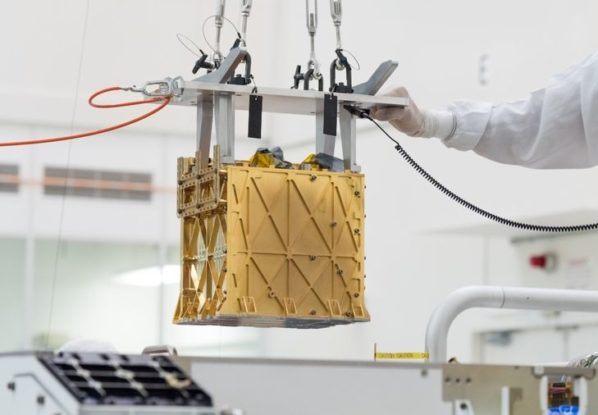The Martian atmosphere, in its current state, is not Earthling-friendly at all. It's extremely thin, over 100 times less dense than Earth's, and is made up mostly of carbon dioxide. Any humans attempting to breathe it would soon find themselves not breathing at all.
But on that dusty, dry, alien world, a small instrument, a little bigger than a briefcase, has been reliably pumping out breathable oxygen from the Martian atmosphere.
It's the first demonstration of the processing of in situ resources for human use on another planet – establishing a way that breathable air could be generated for a human mission to the red planet.
It's called MOXIE ( Mars Oxygen In-Situ Resource Utilization (ISRU) Experiment) and, installed in the belly of NASA's Perseverance rover, it uses a process called electrolysis to split the Martian carbon dioxide into carbon monoxide and oxygen.
Between February 2021, when Perseverance landed, and the end of 2021, MOXIE produced oxygen seven times – and will continue to do so, the researchers said.
"This is the first demonstration of actually using resources on the surface of another planetary body, and transforming them chemically into something that would be useful for a human mission," says former NASA astronaut and MOXIE deputy principal investigator Jeffrey Hoffman of MIT.
"It's historic in that sense."
The production of oxygen by way of electrolysis is not a new thing. The International Space Station, for example, uses electrolysis to split water into hydrogen and oxygen, and thus supplement its supply of breathable air.
However, on Mars, water may be too precious for use in this way, if there is another method available.

Luckily, oxygen is the component of many compounds, including the carbon dioxide that makes up roughly 96 percent of the atmosphere on Mars: a molecule composed of one carbon and two oxygen atoms.
The electrochemical reduction of carbon dioxide into its constituent elements is well studied, known and understood; the challenge was to develop, here on Earth, an instrument that would be able to do so on Mars with the ingredients at hand.
MOXIE's production of oxygen is a multi-step process.
First, it draws in Martian air through a filter that scrubs it clean. This purified Mars air is then compressed, heated, and sent through the Solid OXide Electrolyzer (SOXE). The electrolyzer splits the carbon dioxide into carbon monoxide, which is vented back into the Martian atmosphere, and oxygen ions.
The oxygen ions are then recombined into O2, or molecular oxygen, which is then measured for quantity and purity before being vented back out again.
This process, scientists have determined, has reliably resulted in the production of breathable oxygen. Following several hours of warming up, it runs for 1 hour per experiment followed by a period of powering down. In this 1 hour of operation, MOXIE is designed to produce up to 10 grams – about 20 minutes worth of breathable oxygen for one astronaut.
In each of its seven runs, MOXIE produced between 5.4 and 8.9 grams of molecular oxygen, for a total of 49.9 grams.
Since Mars is highly variable in both temperature and air density, not just from day to night but throughout the changing seasons of the year, MOXIE needs to be able to run in a wide range of temperatures and air densities.
In its seven runs, MOXIE was able to produce oxygen in a variety of conditions: during the day, at night, and throughout the year.
"The only thing we have not demonstrated is running at dawn or dusk, when the temperature is changing substantially," says MOXIE principal investigator Michael Hecht of MIT's Haystack Observatory.
"We do have an ace up our sleeve that will let us do that, and once we test that in the lab, we can reach that last milestone to show we can really run any time."
Ideally, of course, the goal is a life support system that can run continuously since that's how people need to breathe. And it will need to be a lot bigger than MOXIE: A small team of astronauts, Hecht said last year, will require around one metric ton of breathable oxygen for a single year on Mars.
And that doesn't include the oxygen required for propellant for the journey home – in total the mission would need an estimated 500 tons of oxygen, the team calculated.
What the team has learnt in the first year of MOXIE's operations will inform the development of this larger system… but there's still a way to go.
The next experimental run will take place during the time of year when the atmosphere is at its densest. Then, the team said, they will be pushing the instrument as hard as it can go, to try to produce as much oxygen as it can.
This will not only show what MOXIE is capable of, but demonstrate its limitations, which, in turn, will assist in building a more robust machine for the eventual crewed mission to Mars.
And that will solve a significant part of the puzzle involved in not only making an inhabitable place more welcoming to humans – but ensuring their safe return home.
"To support a human mission to Mars, we have to bring a lot of stuff from Earth, like computers, spacesuits, and habitats," Hoffman says.
"But dumb old oxygen? If you can make it there, go for it – you're way ahead of the game."
The research has been published in Science Advances.
